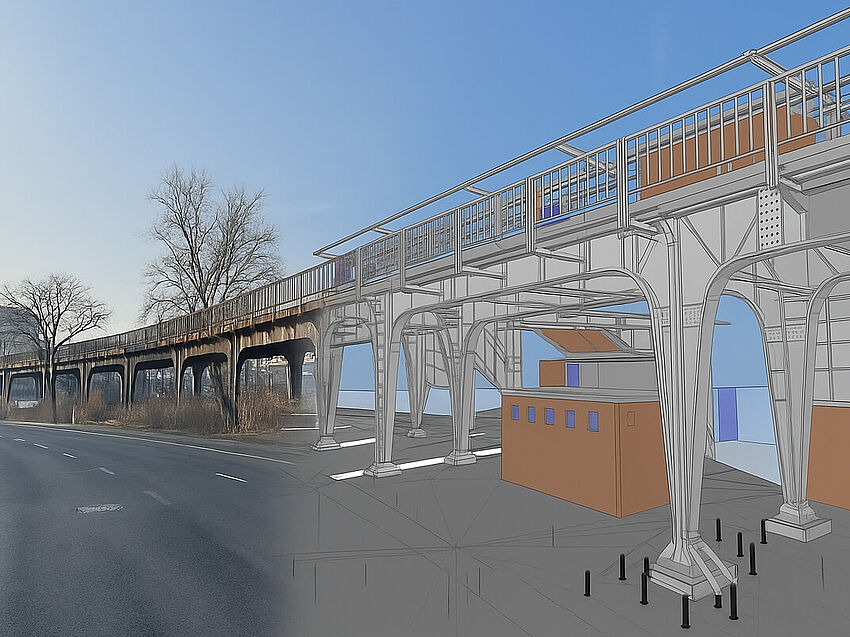Reactivation of the Siemensbahn: KREBS+KIEFER relies on ALLPLAN
Additive manufacturing – also known as 3D printing – has become an area of increasing interest in the construction industry. Using different materials, various equipment and methods have been developed that can print building parts. The advantages of additive manufacturing for construction include automating the production process, significantly improving design freedom, and enhanced opportunities for design optimization of both the building and the components within it. However, to realize these benefits, the components need to be accurately modeled. As a result, it is imperative to ensure that the digital design methods used for designing building components and planning the additive manufacturing processes are robust.
What is Additive Manufacturing in Construction?
Additive manufacturing in construction is closely linked to the type of material that is being printed. The method used to create the building part is dependent on the material used, with concrete, metals, or polymers (plastics) being the most common. With aggregate-based materials like concrete, the material is generally extruded into layers of the desired shape. Alternatively, a particle-bed process is used where the dry materials are layered and then the fluid added afterwards to bond the materials together. Other types of additive manufacturing include dynamic casting and mesh molding for concrete, while metal parts use techniques such as powder bed fusion and directed energy deposition where a heat source fuses the metal together. Plastics – as one of the most adaptable materials – have a wide range of methods that can be used for additive manufacturing, dependent on the type of polymer used.
The Benefits of Additive Manufacturing for Construction
Traditional construction processes such as bricklaying and concrete reinforcement installation are time-consuming, labor-intensive, and come with risks to the safety of the workforce. They also limit the designer to the forms and structural strength that can be achieved with traditional building components.
In contrast, additive manufacturing offers greater design freedom, improves workplace safety and productivity, and lowers production costs. Not only can virtually any shape be produced, objects can be created with varying materials to increase the strength of any areas of the object that will be subject to high loads. This provides designers with new options for optimization of the components. In addition, the automation that additive manufacturing offers makes it particularly suited to construction projects in harsh environments, such as areas affected by atomic radiation.
Are Additive Manufacturing Technologies Ready for AEC?
Additive manufacturing processes are already standard technology in many areas of product manufacturing. Printed components not only speed up the construction of prototypes in development but are also increasingly used in end products like cars and aircrafts. In the construction industry, additive processes are used by innovative companies for the automated production of scaled illustrative prototypes. In the production of real buildings, the particular size of the components and the associated economic conditions pose a particular challenge. Universities and companies worldwide are therefore conducting research on new materials, machines, and processes in order to provide a basis for their use in the architecture, engineering, and construction (AEC) industry.
How to Implement Additive Manufacturing in Construction Projects
To benefit from the possibilities of additive manufacturing in construction projects, a widely automated digital planning workflow is needed. Complex geometric and material data needs to be accurately represented, as well as transferred easily to the manufacturing equipment to be used. 3D printers require specific commands in order to manufacture parts, which is derived from the geometric model of the part in order to create the tool path and other instructions that the 3D printer requires. Therefore, using a civil engineering software solution that can create accurate and complex models and exchange that data reliably and in a useable format is critical for ensuring that additive manufacturing is successful.
As one of the most accurate 3D modeling programs available thanks to the Siemens Parasolid modeling kernel, ALLPLAN Engineering is particularly suited to the needs of additive manufacturing. Any shape can be quickly, easily, and precisely modeled in ALLPLAN, as well as reinforced if needed. With its powerful ALLPLAN Visual Scripting interface, the automation of modeling processes can be achieved even without programming knowledge. ALLPLAN also supports openBIM and vendor-neutral data exchange using the Industry Foundation Classes (IFC) format and the Standard Tesselation Language (STL), which is an industry standard for additive manufacturing.
Additive manufacturing in construction offers considerable freedom of design and extensive possibilities for automation. However, without a digital planning method such as BIM and the right software solution, these benefits would be difficult to realize. As additive manufacturing becomes increasingly adopted across the AEC industry, these requirements will become more important. To find out more about additive manufacturing and its benefits.
Download the following white paper: https://www.sciencedirect.com/science/article/pii/S2214860419309029?via%3Dihub




